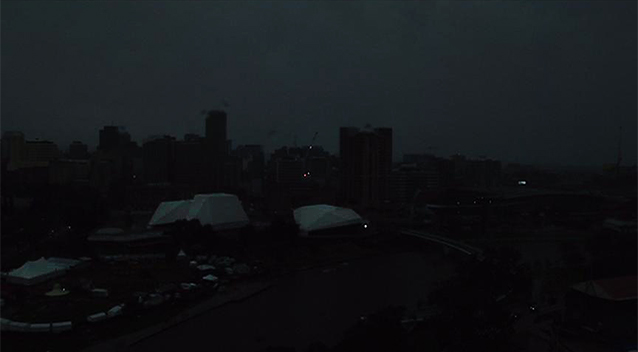
The chaotic delivery of wind and solar has left Australia’s Eastern Grid on the brink of collapse. The Eastern Grid connects Queensland, New South Wales, Victoria, Tasmania and South Australia.
Reliable coal-fired generators have been knocked out of the game, made uneconomic thanks to renewable energy policies that direct more than $3 billion a year in subsidies to wind and solar, and which give wind and solar preferential access to the grid.
The most recent losses – Victoria’s Hazelwood and South Australia’s Northern power plants – resulted in the removal of more than 2,200 MW of reliable supply, at a time when Australia needs it most.
When the sun sets and/or calm weather sets in, wind and solar power output collapses, like night follows day.
That (now routine) chaos has two immediate consequences: spot prices for power go through the roof; and the grid manager starts ‘dumping load’. For power punters, ‘dumping load’ manifests as load shedding (controlled blackouts) and sometimes blackouts involving less deliberation and design.
The renewable energy zealots that hijacked Australia’s Energy Market Operator are less than candid about that relationship.
STT, on the other hand, is only too happy to spill the beans – eg: Wind Power Output Collapses Send Power Prices into Orbit: The World’s Biggest Joke Just Got Serious
Audrey and her gang from the AEMO pull out all stops to blame everything else (except the bleeding obvious) when the lights go out. As they did across Western and Southern Sydney on 25 August 2018.
Dual blackouts put new generation on notice to act fast
The Australian
Ben Packham
27 August 2018
Two vital interstate power interconnectors blew without warning at the weekend, causing blackouts and critical industrial incidents and isolating two states from the national electricity grid, in a dramatic reminder to Scott Morrison just days into his prime ministership of the nation’s energy policy paralysis.
Queensland and South Australia were exporting power across the interconnectors when they were simultaneously tripped on Saturday, forcing power to be cut to big industrial users and retail customers in NSW and Victoria.
The Australian Energy Market Operator last night ruled the transmission failure was caused by a lightning strike, and withdrew a notice to generators to boost supply over coming days as a precautionary measure.
The Prime Minister vowed his government would focus strongly on improving the reliability of the energy system and bringing power prices down, as he announced his new cabinet yesterday, naming Angus Taylor as Energy Minister.
A week after Malcolm Turnbull abandoned plans to legislate carbon emissions cuts for power generators, Mr Morrison sent a strong signal that cutting carbon emissions would no longer dictate energy policy by splitting the energy and environment portfolios.
“It’s reliability, it’s price, it’s keeping the lights on, it’s getting those prices down,” he said.
The electricity interconnectors between Queensland and NSW, and between Victoria and SA, tripped simultaneously at 1.12pm on Saturday and remained down for about 90 minutes. “SA operating in an Island. Queensland region operating in an island. NSW and Victoria remain connected,” the AEMO advised customers in an alert. The AEMO said there was 724 megawatts of load shed — industry jargon for power blackouts — in NSW, 280MW in Victoria and 80MW in Tasmania.
The nation’s biggest single-site power user, the Tomago aluminium smelter in the NSW Hunter Valley, lost power without warning, halting two pot lines for up to an hour. Alcoa’s Portland smelter in Victoria was also affected, losing power for about 50 minutes.
Thousands of households across NSW lost power, while the outage caused signalling problems and delays on Sydney rail networks.
The Energy Users Association of Australia said the transmission failure highlighted the need to urgently address system reliability. “If this had happened on a weekday, the impact of cutting power in two states would have been dramatic on business,” association chief executive Andrew Richards said. “To remain internationally competitive, reliability, affordability and security of supply of our energy systems need to be a critical focus for Australia.”
Resources Minister Matt Canavan said the incident demonstrated the need for urgent investment in reliable power sources. “The system has heightened vulnerability because of the reliance on interstate and unreliable power,” Senator Canavan said. “More investment in coal, gas or hydro would firm up the system, create more supply and bring down prices.”
A spokesman for NSW transmission line operator TransGrid said the interconnector appeared to have tripped during a storm passing through northern NSW and Queensland. “The way the system alarmed was consistent with a lightning strike,” a spokesman for TransGrid said.
Ausgrid said 37,000 homes were affected in Sydney’s inner west, as well as at Empire Bay on the NSW central coast.
Endeavour Energy, which covers 2.4 million people across Sydney’s greater west, the Blue Mountains, Southern Highlands, Illawarra and south coast, said 7000 homes around St Marys in Sydney’s outer west, and 2800 homes at Tomerong on the south coast, were without power for 10 minutes.
Essential Energy said 30,000 customers in Sawtell, Raleigh, Port Macquarie, Kew, Laurieton, Taree, Harrington, Old Bar, Wingham and Coopernook were without power until 3.50pm.
The collapse of Mr Turnbull’s national energy guarantee last Monday amid a backbench revolt heralded the end of his prime ministership.
Mr Morrison, in his first press conference as Prime Minister, committed to implementing competition watchdog recommendations to bring power prices down and encourage investment in new generation.
These included a price safety net, underwriting dispatchable power investment, and “big stick” powers to force companies to divest parts of their operations as a last resort.The AEMO last month released a strategic plan calling for new interconnectors between the four affected states to reinforce the system and foster the development of new generation capacity.
Unplanned power outages at aluminium smelters can be disastrous, but both affected plants managed to restart operations without damaging valuable infrastructure.
The Australian
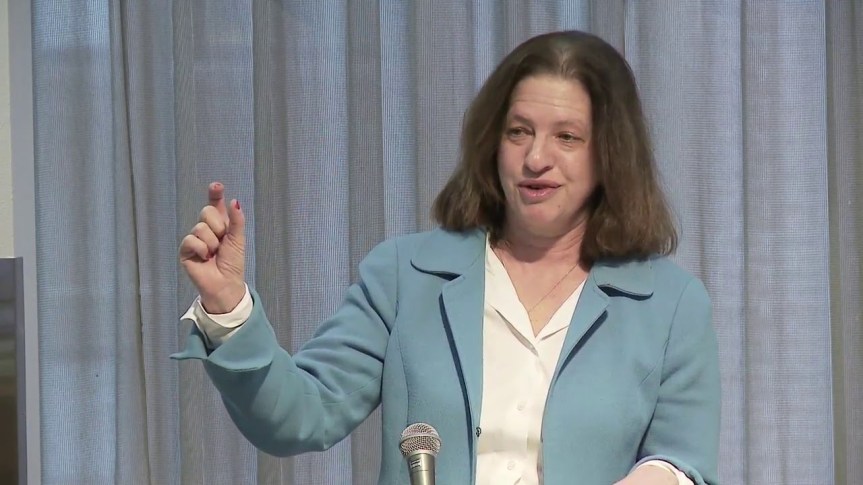
As one would expect from a true ideologue, Audrey Zibelman never lets the facts get in the way of her quest for an all wind and sun powered future.
The idea that 724 MW of generation went AWOL, without warning, without notice, sounds awfully suspicious to STT.
Hunting the likely culprit down is, of course, only a few clicks away – thanks to the boys over at Aneroid Energy.
So let’s take a look at how Audrey’s beloveds were performing on 25 August. Here’s the effort from the entire team with a notional capacity of 5,300 MW:
Hmmm. Was a 1,200 MW collapse in wind power output over the critical period what Audrey was having so much trouble putting her finger on?
Queensland’s wind power capacity is a trivial 180 MW and managed to muster up no more than 20MW that day, so we’ll take a look at NSW where – during the critical period – output was less than 100 MW, having dropped from around 270 MW over the morning:
The effort from the Apple Isle, Tasmania was never more than 80 MW and less than half that for the best part of the day:
Victoria managed a risible -6 MW at noon (ie its fleet were literally sucking power from the grid), less than 60 MW during the critical period and never more than 130 MW:
Over in SA, the wind power capital of the world, output bottomed out at 23 MW – after an interconnector killing collapse of 400 MW, during the critical period:
Electricity grids are sophisticated systems, designed to operate in a sophisticated fashion. They are not designed to tolerate the kind of abuse dished up on a daily basis by wind and solar. Throwing 2-3000 MW into a system (without warning) and ripping that magnitude of power out of that system (again without warning) is enough to kill it.
The thing is so finely balanced now, that each and every time wind and solar output collapses there’s a game of musical chairs being played between the states, as they attempt to snaffle or retain rapidly dwindling supply.
The game is being referred to as ‘islanding’ (see above).
When SA’s wind output suddenly dropped by 400 MW, it was seeking to make up the shortfall by drawing power from NSW and Victoria over two interconnectors (Heywood and MurrayLink). Except, just like old mother Hubbard who opened the cupboard, the cupboard was bare.
Seeking to draw more power over the interconnectors than was available, the load became unsustainable and the interconnector was ‘tripped’. That is, it was switched off to prevent to prevent thermal damage to the interconnectors themselves and to prevent the entire system from collapsing, leaving SA on its own and ‘islanded’.
A Saturday in August is hardly a high load day. The fun and games will really commence this summer when widespread load shedding and blackouts are absolutely guaranteed.
With people like Audrey Zibelman in charge it’s little wonder that Australia is in the middle of a power pricing and supply calamity. Although STT hears that Audrey might be forced to pack her bags and purchase a one-way ticket to New York, rather sooner than she intended.
In the more desperate than silly category, was the line from Transgrid’s PR chief about the whole collapse being caused by a single lightning strike. Jo Nova has a little fun with that nonsense.
Another day, another blackout — Lightning is too much for Australian grid now
Jo Nova Blog
Jo Nova
27 August 2018
Last Saturday at 1pm both Queensland and South Australia were cut off from the national grid. In Sydney 45,000 homes lost power for a couple of hours. Shops had to close. Trains were stopped. Passengers were stranded. Traffic signals were not working on major roads. Chaos. Industrial users shut down in a mass of 725MW of load shedding.
Apparently this was due to lightning.
Once upon a time, Australian states were self sufficient, now interconnectors allow us to share problems:
Two states “Islanded” simultaneously
Two vital interstate power interconnectors blew without warning at the weekend, causing blackouts and critical industrial incidents and isolating two states from the national electricity grid, in a dramatic reminder to Scott Morrison just days into his prime ministership of the nation’s energy policy paralysis.
Queensland and South Australia were exporting power across the interconnectors when they were simultaneously tripped on Saturday, forcing power to be cut to big industrial users and retail customers in NSW and Victoria.
The nation’s biggest single-site power user, the Tomago aluminium smelter in the NSW Hunter Valley, lost power without warning, halting two pot lines for up to an hour. Alcoa’s Portland smelter in Victoria was also affected, losing power for about 50 minutes.
It would have been worse on a weekday.
Ausgrid working to restore power to thousands after mass Sydney blackout
TRAFFIC is at a standstill, trains are delayed and almost 40,000 homes were left without power thanks to a huge power outage. — news.com.
“Consistent” with a lightning strike:
A spokesman for NSW transmission line operator TransGrid said the interconnector appeared to have tripped during a storm passing through northern NSW and Queensland. “The way the system alarmed was consistent with a lightning strike,” a spokesman for TransGrid said.
Before the advent of interconnectors, a lightning strike could not have blacked out customers in three states simultaneously.
Predictably renewables fans are calling for more interconnectors. Other people just want each state to have reliable baseload generation like we used to have.
Jo Nova Blog
At 40C Victoria has a one in three chance of blackouts in summer
Jo Nova Blog
Jo Nova
25 August 2018
In Victoria, 40C used to be known as “A Hot Day”, but now thanks to climate change it’s called an “extreme condition” (wasn’t it meant to become a common event?) Nevermind.
The AEMO (Australian Energy Market Operator) has pretty much warned us the Victorian electrical grid can no longer cope with “a hot day”.
[The AEMO] predicts a one-in-three chance of load shedding under extreme conditions this summer unless additional action is taken.
“Specifically, temperatures of 40C or more in Victoria could be the catalyst for extreme, one-in-10-year electricity demand conditions.
“Particularly when these temperatures are experienced towards the end of the day when business demand is still relatively high, residential demand is increasing, and rooftop PV’s contribution is declining.”
So since solar PV is useless in this situation, the Victorian government is spending one billion dollars installing Solar PV. One billion dollars of generation that is guaranteed not to work when we need it.
Will the new PM, Scott Morrison, be able to solve this problem? Thousands of engineers can.
Once upon a time even the brainless inanimate free market did.
Jo Nova Blog


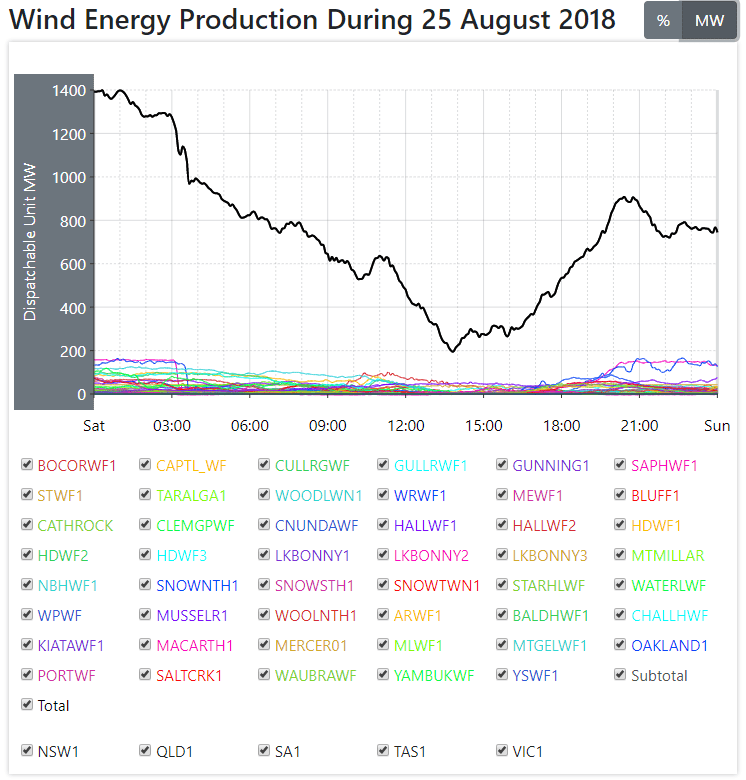
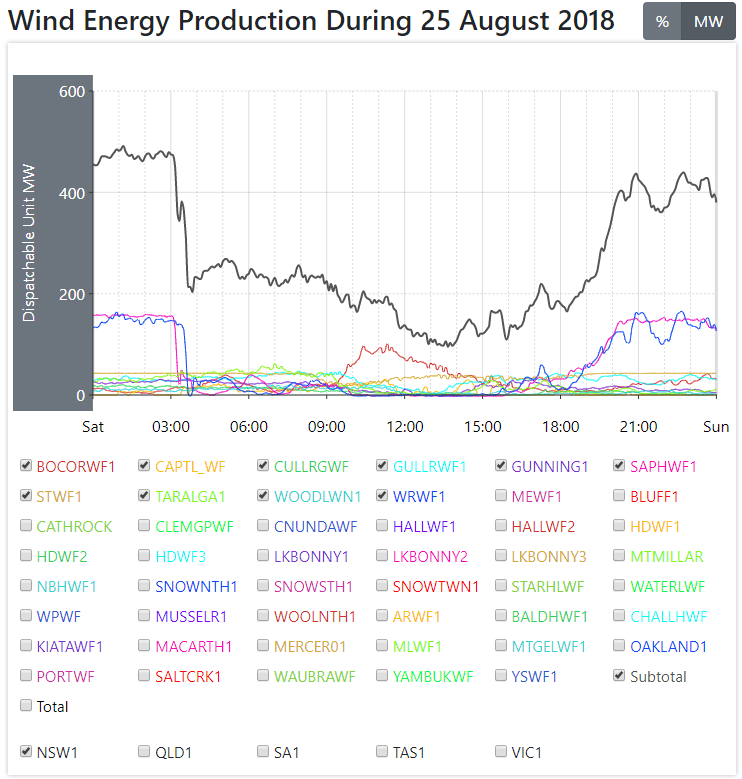

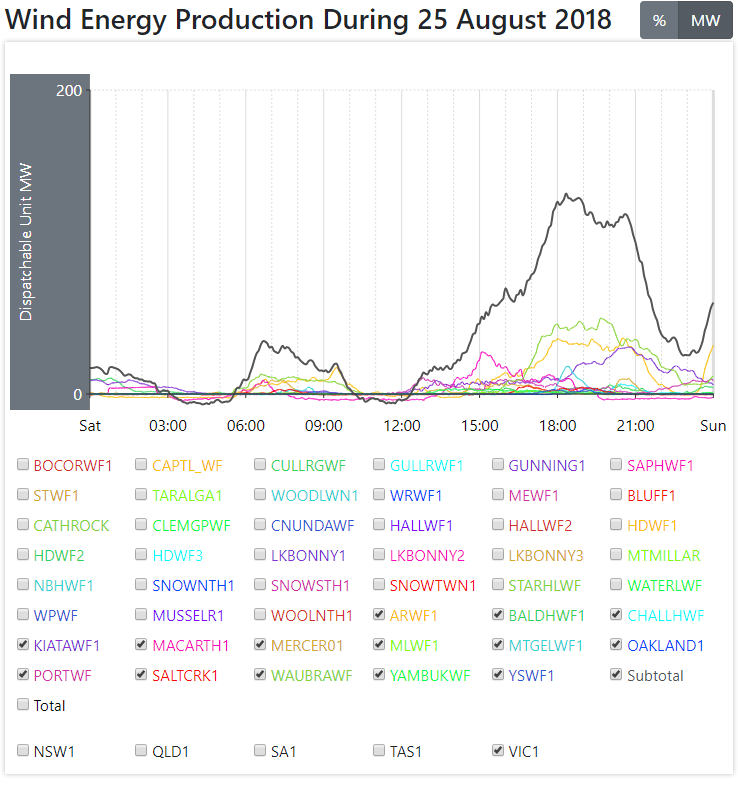
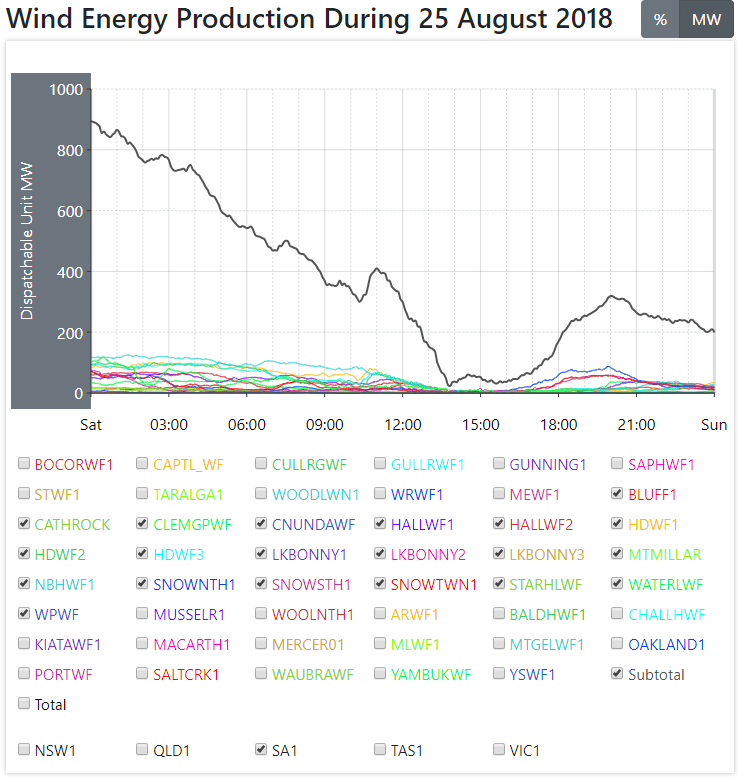
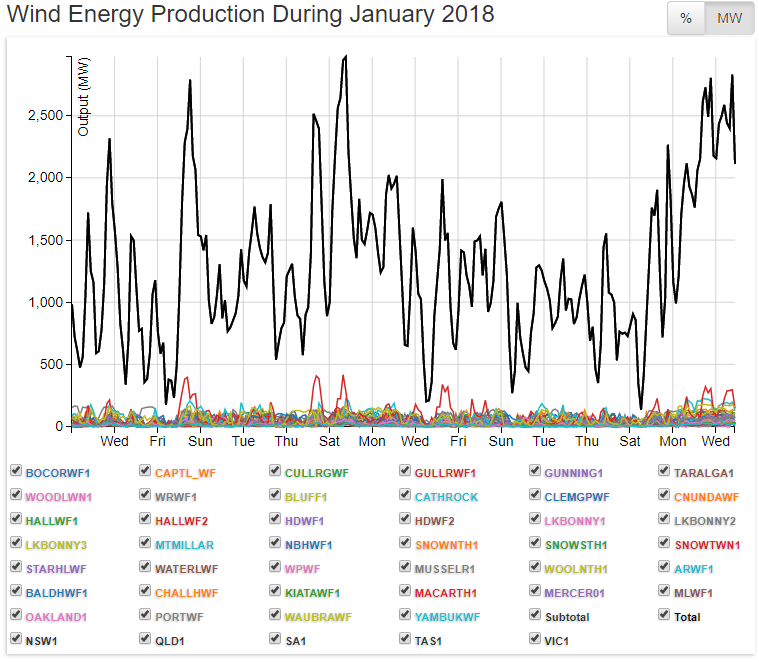
The controlled blackouts you mention also have a blacker, unspoken of cousin – induced periods of mains electricity frequency drop. SA is not above using this as an alternative to the more obvious load dumping you reference.
This is a more covert coping mechanism with potentially far more catastrophic but unpredictable consequences. Anything from building HVAC to local transformers can fail – usually due to overheating after a period of supply frequency below limits. Sensitive electronics such as in hospitals and laboratories are also vulnerable without stabilized/UPS protection.These failures can be near impossible to trace back to a mains frequency drop on an individual basis.
Rolling blackouts have far too much political blow-back to be adopted as a first resort – with a lax (or even willing) electricity regulator – periods of frequency drop in SA could already be a regular occurrence.
Sparkies in SA inform us that voltage has been reduced to 230 to compensate for upward spikes that occur with surges in wind or solar output.
ABC ‘CLIMATE CHANGE’ 24 are broadcasting that climate sceptics are ‘stupid’.
If the threat is real, then it is the climate changers that are being ‘stupid’ for standing in the way of nuclear power generation for base load energy supply.
I would take this one step further and suggest that construction is fast tracked. Jobs would be created with a goal to reducing emissions dramatically. Additionally, wind industry employees could be retrained to work on these developments. The task now is to find the locations to build these facilities. In my mind I have already picked several potential sites. But it is ultimately up to individual communities to put forward their support. Australia has space. Let’s use it wisely. These projects shouldn’t need to be on anyone’s doorstep, unlike the current rash of industrial scale wind farm and solar developments.
As stated here a highly complex and sophisticated Generation and Grid system run by a bunch of tree huggers, failed lawyers and politicians, now who can see a problem here. I doubt any Engineer with half a brain would want to get involved with this bunch of losers.
I hope Angus Taylor can turn the electricity debacle around, but there are a few of things of concern:
1. He’s supposedly focussed on price. Granted, this is probably a lot of political spin, but politicians inevitably get wound into knots focussing on something they have little control over. The danger is that he’ll start picking “winners” who promise the lowest price and the market will revert to a similar issue that existed under Turnbull. Hopefully, it’s polit-speak for levelling the playing field, removing barriers to entry (eg. RET) and encouraging supply, in which case the prices will look after themselves. Much of the country thinks the coal generating industry is responsible for the high prices.
2. There has been no condemnation of the Paris accord and climate change. While they continue to flirt with complying with both, it simply provides a continuing rallying point for the looney left and renewable marketers.
3. Time. The coalition needs to translate energy policies into votes…and quickly. The electricity market has been starved of supply and this situation won’t be turned around quickly.
What he is proposing is a lot, lot better than the Turnbull administration. At least the coalition is finally swimming in the right direction. Hopefully not too little too late.
Brilliant post STT – the facts laid bare for all to see. Not everybody is looking, but they will eventually or ‘reality’ will become their worst nightmare as the fantasies vaporise right before their eyes.
Ben Packham :
‘Queensland and South Australia were exporting power across the interconnectors when they were simultaneously tripped on Saturday, forcing power to be cut to big industrial users and retail customers in NSW and Victoria.’
I do not buy ‘simultaneously’. The probability of two separate simultaneous events that are completely independent is zero. Even if the time difference is a split second, there is cause and effect here. It is our old friend: a grid cascade trip.
So which came first and why? What parameter did the first breaker trip on? Was it overload? We need sight of the load graphs on the SA/Victoria breaker[S] and on the Queensland/NSW breaker[S?] prior to the incident. Emphasis on the [S].
There was a time when the SA/V circuit[S] were derated, so that a trip of one circuit did not cascade trip the second. Were both SA/V circuits fully loaded, so that a trip of one guaranteed a overload trip of the other? Grids are supposed to be operated in a single failure proof manner.
If this incident was really a cascade trip,following overload, then a full forensic examination of the generation performance is needed, just as happened after the SA statewide blackout. Again, if the real cause was overload on exported power from SA, then additional generation in SA would not have helped prevent this incident. That points to a lack of adequate fossil-fired generation in NSW/Victoria.
Ben Packham again:
“The way the [Queensland/NSW] system alarmed was consistent with a lightning strike,”
And what other trip parameters could it have been consistent with? I get a strong whiff of bulls’ manure from this one. Let’s have the real evidence for each stage of the cascade failure.
GADAB, surely a line trip (even one caused by lightning) cutting imports to NSW/VIC from Qld would put both those generation deficient states into grid crisis and would also threaten the SA grid? State self preservation, even pre-renewables era, would demand that when the rate of fall in the interconnected system frequency threatens the stability of a state grid then line protection must do the things that will allow that state grid to recover independently, “every man for himself”? That is, trip interstate tie lines and initiate load shedding to arrest the fall in system frequency?
Stated power supply from QLD to NSW prior to the incident: 866MW
The QNI capacity of both[1:] circuits is 1078W[2:]. Both circuits must have been in operation to carry 866MW.
Q1: If you want a single failure proof QNI interconnector, then what is the maximum permissible load on both circuits of the interconnector?
A1: 539MW, preferably shared half and half.
Q2: If you do not operate in a single failure proof manner, then what are the consequences of a single circuit failure for any reason?
A2: A cascade trip of the second circuit, that leads to a systemwide transient that is only halted by a AUFLS trip of both Tomago and Portland smelters. The QNI trip shed 866MW of supply and the smelter load shed 850MW of demand. A neat fit that made the transient survivable without a total system black.
Tomago drops 600MW
Portland drops 250MW
Q3: Why would AEMO expect any different result?
A3: Because they have not learnt the lessons of the SA statewide blackout.
Q4: Is AEMO going to make a habit of doing this[3:] ?
A4: Over to Angus for that one.
[1:]
https://en.wikipedia.org/wiki/Queensland_E2%80%93_New_South_Wales_Interconnector
The Queensland – New South Wales Interconnector (QNI) is a 330 kV AC interconnection between New South Wales and Queensland, Australia. The link was commissioned in 2001. It consisted of double-circuit 330 kV lines between Armidale, Dumaresq, Bulli Creek and Braemar, and a double-circuit 275 kV line between Braemar and Tarong.[1
[2:]
Click to access Interconnector-Capabilities.pdf
QNI nominal capacity From To Nominal Capacity
Queensland NSW 1078 MW
[3:]
Click to access Analysis_of_Failures_in_Power_Grids.pdf
Analysis of Failures in Power Grids
GADAB apologies for the delay in my response.
The most credible report I have seen is AEMO's own preliminary report:
Click to access Preliminary-report-Qld-SA-System-Separation-25-August-2018.pdf
My rough understanding is:
The event was initiated by lightning striking (or flashing over to?) both circuits of the double circuit Queensland to NSW interconnecting transmission line (QNI) somewhere near the Queensland/NSW border causing protection to trip both circuits separating Queensland from the eastern grid. At the time of the fault the line was supplying 857 MW into NSW. There's more to come from AEMO on the details of this fault(s) and many other aspects of the event with final report expected near the end of October.
The islanding of SA happened around 8 seconds after the initial Qld – NSW line trip and appears to have been an as designed emergency control response tripping of the Vic to SA Heywood transmission line. Immediately before it was tripped the Heywood line had been supplying 430 MW from SA to Victoria, having increased from 165 MW at the time of the initial QNI trip 8 seconds earlier. This trip wasn’t a cascaded protection operation but was initiated by the Heywood Emergency Control Scheme when the interconnected system frequency fell to just above 49 Hz, presumably to help SA avoid a repeat of their system black last year.
AEMO changed the rules for SA grid operation to ensure a minimum of high inertia synchronous generation (gas) following the multiple failure of wind farms and the failure of the SA AUFLS during the system disturbance leading to the SA system black. I'm not sure but suspect the Heywood Emergency Control Scheme may be something new aimed at helping the SA grid from falling apart again. It seems this time the outcome for the SA grid was satisfactory.
In Vic, NSW and Tasmania from what I can see the AUFLS schemes worked as intended shedding both customer load and pot lines. Vic, NSW and Tasmania did not separate and with an increase in power being exported from Tasmania to Vic via BassLink all three interconnected states recovered.
After the Queensland separation a few generators apparently tripped others backed off generation to correct the rising frequency. There was some fiddling by AEMO shortly after the incident with the reclassification of the largest credible contingency to 350 MW. This forced some generating units in Qld to reduce generation for a time maybe because without the connection to the rest of the grid they were unable to cover a single contingency such as a trip of the 750 MW Kogan Creek unit, which was operating at the time, see screen shot from grid publicknowledge here, site address:
http://grid.publicknowledge.com.au/WS/page.htm?Req=%5BTp=Inst;Sel=%5BTp=LC;Cls=C_State;IG=%5BTp=Thing;IId=300;NM=Queensland%5D%5D;View=%5BTp=LCR;Cls=C_State;NM=AddDivDateUnitPlots;Use=Aspect%5D;Area=AspectTabs%5D
So it seems grid protection and control measures performed pretty much they should have during a would-be non credible single contingency event.
AEMO seems to be umming and aring a bit about the classification of the QNI double circuit line i.e. whether at the time of the lightning strike the line should have been temporarily reclassified as vulnerable making the coincident loss of both circuits a credible contingency. AEMO apparently keeps a list of double circuit transmission lines it considers can become vulnerable when lightning is in the vicinity. Had the total loss of the QNI line thus become a credible contingency, when presumably AEMO would have imposed a constraint on the allowable MW exported on the line, e.g. say 400 MW instead of the 800 + MW it was carrying when it tripped. The constriction would have meant not only that the contingent loss south of the QNI connection was only 400 MW instead of 800 + MW but also there would have been more dispatchable generation connected to the southern portion of the grid. Under these conditions the need for load shedding could probably have been avoided.
Had there not been the component of unreliables generating at the time in the southern states, which wouldn't have been the case if AEMO's grid dispatch was based on reason rather than on the government/RET based fiction of unsubsidised price, then the southern states would have had a substantial component of dispatchable synchronous generation. Needless to say there would have been no wind or PV solar. With more synchronous generation the chances of avoiding load shedding would have been better but not non-existent.
A single non credible contingency is not catered for under normal grid operating rules, it seems the double circuit QNI line had become vulnerable due to the proximity of lightning and that AEMO should have reclassified the loss of that line to be a single credible event. They didn't and the line was tripped while carrying more than 857 MW, too much generation loss for the separated southern grid to recover from without load shedding.
I suspect we'll read more on this in the AEMO final report.
Thanks for the analysis, Bon.
I drove past the Adelaide Oval late last Saturday night and on the big electronic screen above Telstra Plaza flashed up an advertisment ;
“Phil Collins – Not dead yet” tour 2018.
Maybe the Lovely Audrey and her chief spear throwers in Boy George and Bird Brain Chloe are on their last tour of duty?
Why at Audrey’s farewell soiree I can visualize Kane Thornton bursting into a moving rendition of the power ballad “Against All Odds”, with backing vocals from the Women of Renewables.
“How can I just let you walk away,
just let you leave without a trace?
When I stand here taking every breath with you,
Ooh, your the only one who really knew me at all”
Reblogged this on Climatism and commented:
“Resources Minister Matt Canavan said the incident demonstrated the need for urgent investment in reliable power sources. “The system has heightened vulnerability because of the reliance on interstate and unreliable power,” Senator Canavan said. “More investment in coal, gas or hydro would firm up the system, create more supply and bring down prices.”
CHOP CHOP Matt Canavan and the new, less-Socialist ‘conservative’ LNP party.
Taxpayers are doing it tuff and demand action on energy-poverty, not more words.